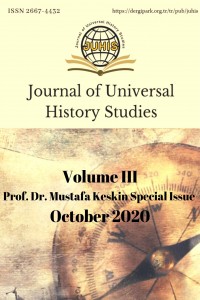Araştırma Makalesi
Yıl 2020,
Cilt: 3, 238 - 251, 06.10.2020
Öz
Dünya tarihinde büyük tesirler bırakan Türk kavimleri veya devletleri, anayurtları Orta Asya coğrafyasından; iklim yetersizliği, otlak alanlarının daralması, çeşitli hastalıkların meydana gelmesi ve bir takım siyasi nedenlerden dolayı batıya doğru göç etmek zorunda kalmışlardır. Farklı kıtalar üzerinde etkisini gösteren bu büyük göç hareketlerinin doğası gereği kavimler ister istemez birbiriyle mücadele etmek zorunda kalmışlardır. Rus tarihi ve siyasi yapısı üzerinde de adından söz ettiren Kuman-Kıpçaklar, Kafkaslardan başlayıp, Karadeniz kuzeyindeki bozkırlar, Orta Avrupa, Balkanlar ve kadim Anadolu coğrafyasına kadar geniş bir alana sahip olmuşlardır. Kuman-Kıpçaklar, bu geniş coğrafyada; Hazar, Moğol, Gürcü, Selçuklu, Rus, Bulgar, Macar ve Bizans İmparatorluğu gibi döneminin güçlü devlet ve toplulukları ile de etkileşim içerisinde olmuşlardır. VIII. asrın sonlarından başlayarak XV. asra kadar, Doğu Avrupa coğrafyasında Peçeneklerin ardından Kuman-Kıpçaklar bölgede uzun müddet yaşayarak siyasi ve askeri anlamda önemli kazanımlar elde etmişlerdir. Kumanlar ve Ruslar bazen düşman bazen ittifak halinde bulunmuşlardır. Kiev knezlerinin arasında çıkan çatışmalarda akrabaları olan Kumanlardan yardım talep isteğinde Kuman hatunlarının etkisi bariz bir şekilde görülmektedir. Böylelikle Kumanların Rus knezliklerinin iç işlerine müdahale etmişler ve bu çatışmalardan faydalanarak Rus sınırlarını yağma ve bolca ganimet elde etmişlerdir. Kumanların, Rus knezliklerinin bu daveti Ruslar için ağır sonuçlara neden olmuştur. Nitekim Moğolların, Doğu Avrupa coğrafyasına gelene kadar bu iki halk mücadele ve akrabalık ilişkileri arasında yaşamaya devam etmişlerdir.Yaşadıkları dönem içerisinde Kuman-Kıpçaklar stratejik bir bölge olan Karadeniz’in kuzeyine hâkim olarak Rus yayılmacılığının önünü uzun bir zaman kesmiş ve bu coğrafyanın “Türk Toprakları” olarak kalması gibi önemli bir görevi üstlenmişlerdir.
Anahtar Kelimeler
Kaynakça
- [1] Ahincanov, M. Sercan (2009), Türk Halklarının Katalizör Boyu Kıpçaklar, Selenge Yayınevi, İstanbul.
- [2] Ahmetbeyoğlu, Ali (2014), Sorularla Eski Türk Tarihi, Yeditepe Yayınları İstanbul.
- [3] Ebülgazi Bahadır Han, Şecere-i Terakkime (Türklerin Soy Kütüğü), (Haz. Muharrem Ergin), Tercüman 1001 Temel Eser.
- [4] Çoban, Erdal (2015), Orta Çağ’ da Kumanlar ve Macarlar, Nobel Akademik Yayıncılık, Ankara. [5] Golden, B. Peter (2002), Türk Halkları Tarihine Giriş, (Çev. Osman Karatay), Karam Yayınları, Ankara.
- [6] Golubovsky, Petr (2011), Peçenegi, Torki i Polovtsi Do Naşestviya Tatar (Moğol
- [7] İstilasına kadar Peçenekler, Uzlar ve Kuman-Kıpçaklar), Moskova, Veçe, 2011.
- [8] Gökbel, Ahmet (2000), Kıpçak Türkleri, Ötüken Yayınları İstanbul.
- [9] Gökbel, Ahmet (2005), “Kıpçaklar/Kumanlar”, Türkler, Cilt 2, Yeni Türkiye Yayınları, Ankara.
- [10] Gumilev, Lev Nikolayeviç (2006), Eski Ruslar ve Büyük Bozkır Halkları, Cilt 1-2, (Çev. Ahsen Batur), Selenge Yayınları, İstanbul.
- [11] Güngör, Erol (1989), Tarihte Türkler, Ötüken Yayınları, İstanbul.
- [12] Kaşgarlı, Mahmud (1985), Divan-ü Lügat-it Türk, (Çev. Besim Atalay), Türk Dil Kurumu Yayınları, Ankara.
- [13] Kafesoğlu, İbrahim (2013), Türk Milli Kültürü, Ötüken Yayınları, İstanbul.
- [14] Kırzıoğlu, Fahrettin (1992), Kıpçaklar (Yukarı- Kür ve Çoruk Boylarında), Türk Tarih Kurumu Yayınları, Ankara.
- [15] Kurat, Akdes Nimet (1992), IV-XVIII. Yüzyıllarda Karadeniz Kuzeyindeki Türk Kavimleri ve Devletleri, Murat Yayınevi, Ankara.
- [16] Markov, Vladimir (2016), Türkskiy Sled v İstorii Ukrainı X-XVII v.v(10-17. Asırlarda Ukrayna Tarihinde Türk İzleri), Petersburg.
- [17] Minorsky, Vladimir(2008), Hudûdü’l-Âlem Mine’l-Meşrik İle’l-Magrib,(çev. Abdullah Duman-Murat Ağarı), Kitapevi, İstanbul.
- [18] Pletneva, Svetlana (1990), Polovtsı(Kumanlar), Moskova.
- [19] Povesti Vremennıh Let (Geçmiş Yılların Hikayesi) (1950), (Haz. D. S. Lihaçeva – B.A. Romanova), Moskova-Leningrad.
- [20] Rasovsky, Dmitry Alexandrovich (2012), Peçenegi, Torki i Berendei na Rusi i v Ugrii (Rus’ da ve Ugriya’ da Peçenekler, Torklar ve Berendiler), Moskova.
- [21] Sarıahmetoğlu, Nesrin (2013), Rusya Tarihi, Anadolu Üniversitesi Yayınları, Eskişehir.
- [22] Taşağil, Ahmet (2014), Kök Tengri ’nin Çocukları, Bilge Kültür Sanat Yayınları, İstanbul.
- [23] Togan, Zeki Velidi (2019), Umumi Türk Tarihine Giriş, Cilt 1-2, Türkiye İş Bankası Yayınları, İstanbul.
- [24] Yalvar, Cihan (2018), “Deşt-i Kıpçak’ ta Moğol Hâkimiyeti ve Kuman-Kıpçaklar”, Yedi Tepe Üniversitesi Tarih Bölümü Araştırma Dergisi Cilt 2, Sayı 1, Ocak. (3-29).
- [25] Yücel, Mualla Uydu (2007), İlk Rus Yıllıklarına Göre Türkler, Türk Tarih Kurumu Yayınları, Ankara.
- [26] Yücel, Mualla Uydu (2013), Doğu Avrupa Türk Tarihi, (Editör: Osman Karatay- Serkan Acar), Kitapevi Yayınları, İstanbul.
Yıl 2020,
Cilt: 3, 238 - 251, 06.10.2020
Öz
Having given a big impression on World history, Turkish tribes or states had to migrate from their mainland in Central Asia to west because of lack of climate, shrinking their greenland, various diseases and a number of political reasons. This massive migration movement on different parts of regions inevitably required to struggle with each other. Being mentioned on Russian history, Cuman-Qipchaqs had a great area from caucasia, moorland in the Black Sea, Middle Europe, Balkans to Anatolian geography. In this vast geography, Cuman-Qipchaqs interacted with some strong states during that period such as Khazar, Mongol, Georgian, Selcuks, Russian, Bulgarian, Hungarian and Byzantine Empire. From the late of thirteenth century to fifteenth century, in East European geography Cuman-Qipchaqs lived for a long time after Peçeneks. Cumans and Russia were sometimes enemy and sometimes allied forces. And they acguired big achivements over military and political area. Cuman ladies were effective to help to Kievan Rus when they had a conflict . And therefore Cumans interfered in Kievan internal affairs and they acguired a big proportion of property from Russia. The invasion of Kievan Rus to cumans caused Russia to defeat heavily against cumans. Until mongols arrived in border of East Europe, these two states remained to live between this struggle and relativity. During their period, Cuman-Qipchaqs cut Russian invasion for a long time, dominating a strategic region at the north of Black Sea and they enabled this territory to remain as Turkish land.
Anahtar Kelimeler
Kaynakça
- [1] Ahincanov, M. Sercan (2009), Türk Halklarının Katalizör Boyu Kıpçaklar, Selenge Yayınevi, İstanbul.
- [2] Ahmetbeyoğlu, Ali (2014), Sorularla Eski Türk Tarihi, Yeditepe Yayınları İstanbul.
- [3] Ebülgazi Bahadır Han, Şecere-i Terakkime (Türklerin Soy Kütüğü), (Haz. Muharrem Ergin), Tercüman 1001 Temel Eser.
- [4] Çoban, Erdal (2015), Orta Çağ’ da Kumanlar ve Macarlar, Nobel Akademik Yayıncılık, Ankara. [5] Golden, B. Peter (2002), Türk Halkları Tarihine Giriş, (Çev. Osman Karatay), Karam Yayınları, Ankara.
- [6] Golubovsky, Petr (2011), Peçenegi, Torki i Polovtsi Do Naşestviya Tatar (Moğol
- [7] İstilasına kadar Peçenekler, Uzlar ve Kuman-Kıpçaklar), Moskova, Veçe, 2011.
- [8] Gökbel, Ahmet (2000), Kıpçak Türkleri, Ötüken Yayınları İstanbul.
- [9] Gökbel, Ahmet (2005), “Kıpçaklar/Kumanlar”, Türkler, Cilt 2, Yeni Türkiye Yayınları, Ankara.
- [10] Gumilev, Lev Nikolayeviç (2006), Eski Ruslar ve Büyük Bozkır Halkları, Cilt 1-2, (Çev. Ahsen Batur), Selenge Yayınları, İstanbul.
- [11] Güngör, Erol (1989), Tarihte Türkler, Ötüken Yayınları, İstanbul.
- [12] Kaşgarlı, Mahmud (1985), Divan-ü Lügat-it Türk, (Çev. Besim Atalay), Türk Dil Kurumu Yayınları, Ankara.
- [13] Kafesoğlu, İbrahim (2013), Türk Milli Kültürü, Ötüken Yayınları, İstanbul.
- [14] Kırzıoğlu, Fahrettin (1992), Kıpçaklar (Yukarı- Kür ve Çoruk Boylarında), Türk Tarih Kurumu Yayınları, Ankara.
- [15] Kurat, Akdes Nimet (1992), IV-XVIII. Yüzyıllarda Karadeniz Kuzeyindeki Türk Kavimleri ve Devletleri, Murat Yayınevi, Ankara.
- [16] Markov, Vladimir (2016), Türkskiy Sled v İstorii Ukrainı X-XVII v.v(10-17. Asırlarda Ukrayna Tarihinde Türk İzleri), Petersburg.
- [17] Minorsky, Vladimir(2008), Hudûdü’l-Âlem Mine’l-Meşrik İle’l-Magrib,(çev. Abdullah Duman-Murat Ağarı), Kitapevi, İstanbul.
- [18] Pletneva, Svetlana (1990), Polovtsı(Kumanlar), Moskova.
- [19] Povesti Vremennıh Let (Geçmiş Yılların Hikayesi) (1950), (Haz. D. S. Lihaçeva – B.A. Romanova), Moskova-Leningrad.
- [20] Rasovsky, Dmitry Alexandrovich (2012), Peçenegi, Torki i Berendei na Rusi i v Ugrii (Rus’ da ve Ugriya’ da Peçenekler, Torklar ve Berendiler), Moskova.
- [21] Sarıahmetoğlu, Nesrin (2013), Rusya Tarihi, Anadolu Üniversitesi Yayınları, Eskişehir.
- [22] Taşağil, Ahmet (2014), Kök Tengri ’nin Çocukları, Bilge Kültür Sanat Yayınları, İstanbul.
- [23] Togan, Zeki Velidi (2019), Umumi Türk Tarihine Giriş, Cilt 1-2, Türkiye İş Bankası Yayınları, İstanbul.
- [24] Yalvar, Cihan (2018), “Deşt-i Kıpçak’ ta Moğol Hâkimiyeti ve Kuman-Kıpçaklar”, Yedi Tepe Üniversitesi Tarih Bölümü Araştırma Dergisi Cilt 2, Sayı 1, Ocak. (3-29).
- [25] Yücel, Mualla Uydu (2007), İlk Rus Yıllıklarına Göre Türkler, Türk Tarih Kurumu Yayınları, Ankara.
- [26] Yücel, Mualla Uydu (2013), Doğu Avrupa Türk Tarihi, (Editör: Osman Karatay- Serkan Acar), Kitapevi Yayınları, İstanbul.
Toplam 25 adet kaynakça vardır.
Ayrıntılar
| Birincil Dil | Türkçe |
|---|---|
| Bölüm | Araştırma Makaleleri |
| Yazarlar | |
| Yayımlanma Tarihi | 6 Ekim 2020 |
| Gönderilme Tarihi | 26 Eylül 2020 |
| Kabul Tarihi | 6 Ekim 2020 |
| Yayımlandığı Sayı | Yıl 2020 Cilt: 3 |
Journal of Universal History Studies © 2018 by Sabit Dokuyan is licensed under CC BY-NC-SA 4.0



